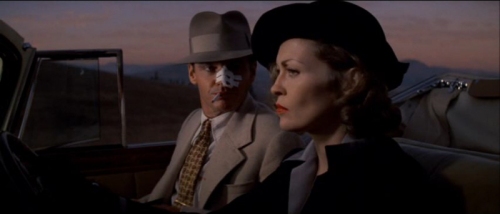Placing Roman Polanski within the parameters of the auteur theory isn’t the simple task it is for other directors. As Paul Coates suggests in his essay on Cul-De-Sac, Polanski may well belong to two separate definitions of auteurism: the kind of auteur that constitutes what Coates asserts is the modern era (where Polanski would find himself aligned with the likes of Antonioni, Godard and fellow Polack Jerzy Skolimowski) and the kind of auteur that is more akin to the original definition of the term, indeed the “classic” one as postulated by Francois Truffaut, the kind that applied to a director who “prided himself on his professionalism,” and “removed the indiscretions of autobiography…by turning them into stories that seem no longer to apply to him,” whose films could be “analyzed in terms of their symbolic concealments”
It was on the basis of this “classic” definition that permitted the Young Turks of Cahiers du Cinema to proclaim that Alfred Hitchcock and Howard Hawks were true artists, on par with the likes of Gaugin and Degas. That Polanski had little regard for the nouvelle vague is evident in his disavowal of classic style. His first three films (Knife in the Water [1962], Repulsion [1965] and most notably, Cul-De-Sac [1966]) are distinct products of the European modern art style that, coincidentally enough, the nouvelle vague helped birth when Godard and Jacques Rivette supplied their films with avant-garde stylistics.
But things changed drastically when Polanski came to Hollywood, culminating in 1974’s Chinatown. Widely regarded as his masterwork and one of the great pieces of American cinema, Chinatown is Polanski’s stab at classic Hollywood filmmaking, co-opting the film noir genre and mirroring the techniques employed by the likes of Hawks and John Ford. However, as indicative of Hollywood classicism as the film is, there’s an air of menace in Chinatown that seems entirely preoccupied with dismantling the myth of Los Angeles. Screenwriter Robert Towne borrowed from William Mulholland’s construction of the Los Angeles Aqueduct just before WWI. Much like the dam project in Chinatown, Mulholland’s scheme forced unbeknownst landowners to sell their properties for far less then their worth, thus paving the way for LA to expand. Mulholland pulled it off in 1905; Chinatown, however, is set in 1938. The film isn’t docudrama: it’s revisionist history.
In terms of modernist tactics, this is far as Chinatown goes in resembling Polanski’s previous work, which had similar disregard for history. The rest of the film is the product of “classic” auteurship, with Polanski’s misanthropic view of Los Angeles materializing itself in the form of the evil Noah Cross. Had Chinatown been a work of docudrama, Hollis Mulwray (the obvious stand in for Mulholland) would have been the film’s central antagonist. Instead, Noah Cross is the almost cartoonish villain: he’s all-powerful, not only capable of committing heinous crimes but getting away with them, too. As an untouchable force of pure evil, Noah Cross likely personifies Polanski’s feelings toward the tragedy that befell Sharon Tate. That he insisted on re-writing Robert Towne’s ending so that the film ended on a note that can be rightly‑though perhaps understatedly—described as pessimistic provides insight into the bleak mind-frame he was occupying. Such an act evokes similar actions taken by the likes of Ford, Hawks, and Nicholas Ray, who often made numerous rewrites to the scripts they were assigned in order to inject more personal elements into the text.
That said, the entire film would have benefited from Polanski taking more liberties with Towne’s script, which is arduous and plodding, at best. It’s novelistic structure, though admirable in a formal sense, actively works against Polanski’s strengths as a filmmaker. His absurdist sense of humor, ability to amble between subjective and objective realism, and his sense of tone and atmosphere are all absent in Chinatown, given no room to prosper thanks to the script’s stranglehold. As Dana Polan correctly notes, there isn’t a single scene in the film that isn’t told from Jake Gittes’s point of view (116). This rigid, even oppressive narrative framework forces the viewer down a predetermined path, making Chinatown a far different‑and less enjoyable‑viewing experience than the likes of Repulsion, Cul-De-Sac, and even Rosemary’s Baby [1969]. Despite its scant narrative, the open-air playfulness of a film like Cul-De-Sac proves to be a more democratic film because of its lack of allegiance to a single character or theme. Similar tactics are used in Rosemary’s Baby, as the mystery of the narrative unfolds with objective suspense. While Polanski may have imbued the text of the film with any number of his trademark visual cues and thematic regularities, Chinatown’s abhorrent inflexibility suggests a distinct lack of authorial intent on his behalf. Polanski’s attempt at a piece of classic cinema only proves that his strengths as a filmmaker lie in more modernist techniques.


